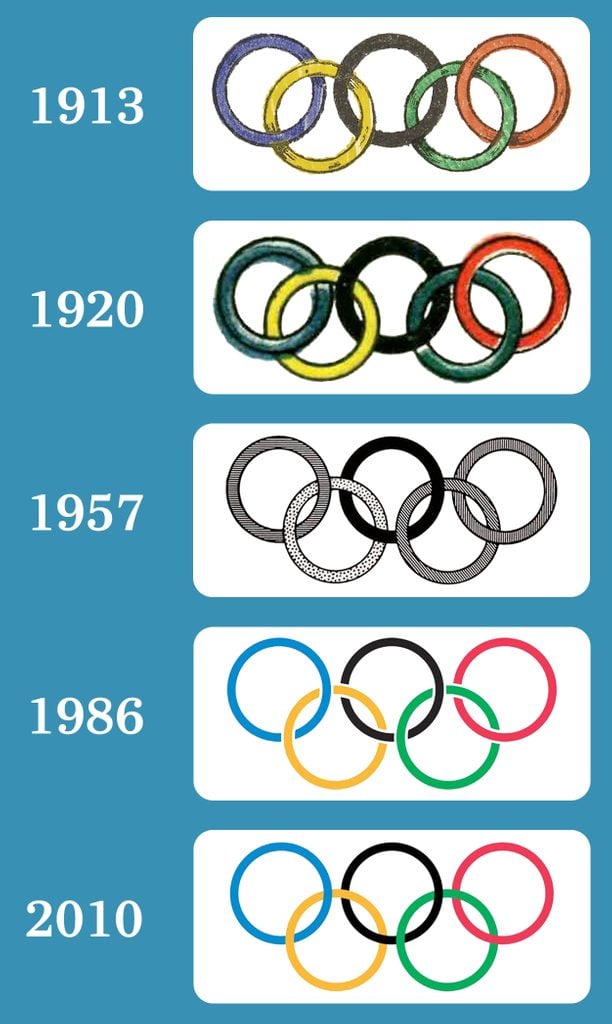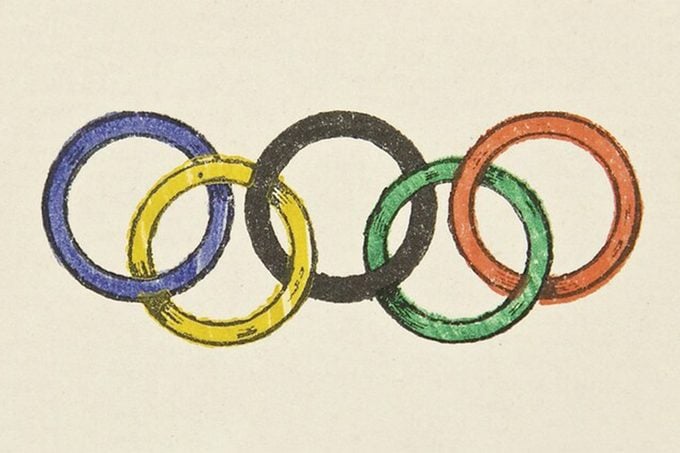How To Tighten Screw On Phone Ring Stand
The famous Olympic rings logo is more than than 100 years quondam, just its symbolism is ageless.
When we call up of the Olympics, a few things come to mind immediately: the athletes marching in during the opening ceremonies, proudly conveying their countries' flags; the dramatic application of gold, silver, and bronze medals to winners of the events; the torch and other memorable Olympic moments; and, of course, the Olympic rings.
The five interlocked Olympic rings take go then familiar at this point, there'due south a expert take chances you don't give them much idea. Given what nosotros know about rings symbolizing an ongoing, unbroken commitment—wedding rings, for example—you may assume in that location'southward a like sentiment behind the Olympic rings, just it's much more that. Hither's what the Olympic rings mean and the story backside their creation.
The history of the Olympic Games
Both the Olympic rings and the modernistic Olympics themselves can be traced back to 1 homo: 19th-century French historian, sociologist, athlete, and education reformer Pierre de Coubertin. In improver to working to make physical didactics available to students in France the way it was to their English counterparts, Coubertin organized the world'south commencement Congress on Physical Educational activity and Scholar Competitions at the 1889 Paris Universal Exposition, according to the International Olympic Committee (IOC). V years later, in June 1894, Coubertin founded the IOC and proposed what would become the modern-twenty-four hours Olympic Games—the offset of which were held in Athens in 1896, followed by the 1900 Games in Paris.
From the very beginning, Coubertin's vision for the Olympics included aristocracy athletes from unlike parts of the earth coming together in 1 location to compete against each other. In the second edition of the Olympic Bulletin in 1894, he spelled out how the Games would rotate between unlike countries, and why that was such an of import aspect of the event. "The genius of each people, its manner of belongings the festivals and of engaging in physical exercise," he wrote, "is what volition requite the modern Olympic Games their true graphic symbol, and perhaps may make them superior to their ancient predecessors. It is obvious that Games held in Rome will not resemble in the slightest those that may be held in London or Stockholm."
The history of the Olympic rings
The 1912 Olympic Games held in Stockholm, Sweden, were the offset to include athletes from what were then considered the five continents: Africa, Asia, Europe, Oceania (Australia and New Zealand), and a combination of North and South America. Inspired by what had become a truly global issue, Coubertin designed what would become the symbol of the Games: the Olympic rings. (His original blueprint from 1913 is shown in a higher place.)
The Olympic rings have been used in every summer and wintertime Games since 1920 and have remained relatively unchanged since. The exception to this was a version introduced in 1957, which slightly increased the infinite between the rings. Still, in 2010, the IOC decided to go back to Coubertin'south original blueprint and spacing—the iteration of the Olympic rings in utilise today.
The meaning of the Olympic rings
Humans have long used rings or circles every bit symbols, but the the Olympic rings' meaning is special. For instance, the five rings represent the five continents that participated in the 1912 Games. And according to Rule eight of the Olympic Charter, "the Olympic symbol expresses the activity of the Olympic Motion…and the coming together of athletes from throughout the globe at the Olympic Games."
Additionally, the five interlaced rings must exist of equal dimensions, representing the idea that all continents are equal at the Games. Lastly, in the words of Coubertin: "These five rings represent the v parts of the world at present won over to the cause of olympism and gear up to accept its fecund rivalries."
The meaning behind the colors of the Olympic rings
Given what we know near colors and their many symbolic meanings, it seems like it'd be condom to assume that each color featured in the Olympic rings would stand for something specific, like a continent. Just in reality, that's non the instance at all. Coubertin chose the six official Olympic colors—blueish, yellowish, blackness, green, ruby-red, and white (featured in the background)—because when he introduced the symbol in 1913, every single flag of the nations participating in the games could be reproduced using the colors in the Olympic symbol. Or, in his own words: "The six colors thus combined reproduce those of all nations without exception."
The official versions of the Olympic rings
Believe it or not, there are currently 7 "official" versions of the Olympic rings, according to the IOC. Unsurprisingly, the preferred iteration is the one featuring the rings in all five colors on a white background. However, in situations where it'due south non possible to reproduce the Olympic rings in color, monochrome versions of the rings in each of the vi official Olympic colors—blue, yellow, black, light-green, crimson, and white—are adequate alternatives.
The evolution of the Olympic rings

While the concept of the Olympic rings may not be new, the symbol itself has evolved slightly over the years and has included these versions, according to the IOC:
- 1913: Coubertin's original symbol featured v interlaced rings—blueish, yellowish, blackness, green, and red—in the middle of a white background. The rings were adopted in 1914, only it would be another six years before they were seen at the Games.
- 1920: The Olympic rings made their official debut at the Games of the VII Olympiad in Antwerp, in the form of the Olympic flag.
- 1957: Later the rings had seen 44 years of use, the IOC approved the first modification of the Olympic rings, though it was extremely subtle. In fact, information technology only differed slightly from Coubertin'southward original; the two lower rings were moved down a bit further, providing additional space between the rings.
- 1986: The IOC updated its Graphics Standards to include a description of the official version of the Olympic rings, complete with how much space should be betwixt each ring when the logo was reproduced.
- 2010: The IOC Executive Board decided that the Olympic rings should render to their roots—as in, Coubertin'southward original version—with the rings interlaced seamlessly.
Sources:
- International Olympic Committee: "The Olympic Rings"
- International Olympic Commission: "Olympic Charter"
How To Tighten Screw On Phone Ring Stand,
Source: https://www.rd.com/article/olympic-rings-meaning/
Posted by: pooreexagavied.blogspot.com



0 Response to "How To Tighten Screw On Phone Ring Stand"
Post a Comment